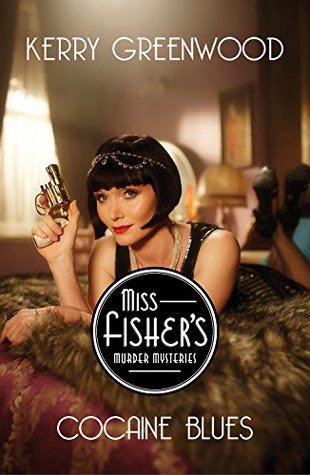 Cocaine Blues (Phryne Fisher, #1) by Kerry Greenwood
Cocaine Blues (Phryne Fisher, #1) by Kerry Greenwood Formats available: paperback, ebook, audiobook
Series: Phryne Fisher #1
Pages: 175
Published by Poisoned Pen Press on April 1st 2006
Purchasing Info: Author's Website, Publisher's Website, Amazon, Barnes & Noble, Kobo, Bookshop.org
Goodreads
This is where it all started! The first classic Phryne Fisher mystery, featuring our delectable heroine, cocaine, communism and adventure. Phryne leaves the tedium of English high society for Melbourne, Australia, and never looks back.The London season is in full fling at the end of the 1920s, but the Honorable Phryne Fisher--she of the green-grey eyes, diamant garters and outfits that should not be sprung suddenly on those of nervous dispositions--is rapidly tiring of the tedium of arranging flowers, making polite conversations with retired colonels, and dancing with weak-chinned men. Instead, Phryne decides it might be rather amusing to try her hand at being a lady detective in Melbourne, Australia.
Almost immediately from the time she books into the Windsor Hotel, Phryne is embroiled in mystery: poisoned wives, cocaine smuggling rings, corrupt cops and communism--not to mention erotic encounters with the beautiful Russian dancer, Sasha de Lisse--until her adventure reaches its steamy end in the Turkish baths of Little Lonsdale Street.
My Review:
Cocaine Blues is simply tremendous fun. Not just that heroine Phryne Fisher is obviously having a marvelous time, but also that the book is fun to read. And Cocaine Blues works excellently as an introduction to the characters and the place and time in which it is set.
The series is named for, and absolutely stars, its heroine Phryne Fisher. Phryne is a bundle of fascinating contradictions, and her rather eclectic background serves the story well. And for those who have watched the utterly marvelous TV series based on the books, the characters as portrayed, with the exception of Jack Robinson, perfectly match the characters as described, at least so far.
Admittedly, in the book Phryne seems to be in her late 20s, but all of the experience she has accumulated (and definitely enjoyed!) make her seem a better match for the actress who plays her in the series, Essie Davis (seen in the book cover picture), who is in her 40s.
But I digress, just a bit. And why shouldn’t I? Phryne often does.
The series is set in late 1920s Melbourne, Australia. Melbourne was not exactly on the beaten path at that point, so the setting is novel, while the time period is a road well traveled. It’s a nice mix of what we know and what we don’t. As much as I liked the setting, occasionally the slang drove me nuts. Most of it was easy to figure out from context after a few minutes of thought, but the meaning of “U.P.” still escapes me.
The strength of the story, what makes it so much fun to read, is the characters. The mystery isn’t all that difficult to solve, but watching Phryne and company pull together and solve it is an absolute blast.
Phryne’s character shines through, and readers need to love her voice to be interested in the series. The story, and all the other characters, orbit around her like satellites. I’ll admit that I loved her voice. It’s irreverent and world-weary, and her inner thoughts reflect her somewhat cynical perspective on the way that things are. She may need to pretend a certain attitude to get what she wants or where she wants, but on the inside we see what she really feels.
She’s also fearless in a way that women seldom are in fiction. She is living her life exactly as she wants it, and will only kowtow to society when she feels it’s necessary, not because it’s “the done thing”.
Phryne is also the living embodiment of Sophie Tucker’s classic saying: “I’ve been rich and I’ve been poor — and believe me, rich is better.” Phryne was literally dirt-poor as a child in Melbourne, until all the men standing between her father and a rich title in England got killed in the Great War. Suddenly, she’s a wealthy heiress. And while she loves the life and the indulgences it provides, she has never lost sight of where she came from. It’s that background that enables her to relate to all the people she gathers around her, from Bert and Cec, the itinerant taxi drivers, to Dot, her earnest, well-meaning and down-on-her-luck, maid and assistant.
The mystery is not that difficult to solve, but the journey to that solution sparkles and fascinates from beginning to end. Just like Phryne Fisher.
Escape Rating A-: This was the right book at the right time for me. I loved it every bit as much as the TV series, although differently. I saw and heard the characters as they are portrayed in the series, and with the exception of Jack, those portraits meshed perfectly. In the book, Jack is described as being completely average and utterly forgettable. In the series he is anything but, as Phryne seems to be discovering.
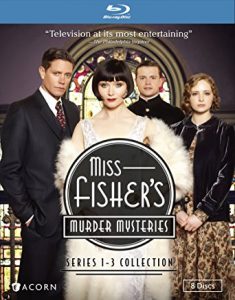 For those who have seen the series and wonder how the book matches the episode, this is one of the few times where the TV show actually is better. The plot is a bit tighter, and what are two loosely connected mysteries in the book become one single and stronger mystery in the episode.
For those who have seen the series and wonder how the book matches the episode, this is one of the few times where the TV show actually is better. The plot is a bit tighter, and what are two loosely connected mysteries in the book become one single and stronger mystery in the episode.
As I wait in hope for a Season 4 of the Miss Fisher Murder Mysteries, I am thrilled to have discovered Phryne in print as a way to while away the time.









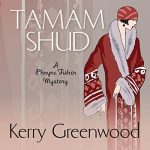

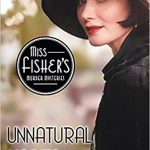
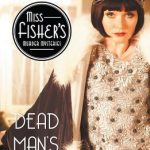
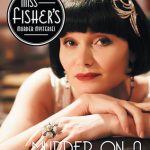







I’ve definitely had my eye on this series – because historical mysteries are my jam and because I do enjoy the TV show. Most of the time. It’s great to hear that the books are really great! As far as U.P., the only thing I’ve seen that used for is the Upper Peninsula of Michigan which I sincerely doubt is a main topic of conversation in 1920s Melbourne;).
That U.P. drove me crazy. I tried looking it up, but it’s much too short and in too common use for other things (it is a real word, after all) that I didn’t have any joy. It’s clearly not good, but I’m not sure how not good.
But this was a terrific way to get back in touch with Phryne again. I miss that show.
Marlene Harris recently posted..Review: Clean Sweep by Ilona Andrews